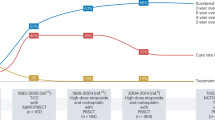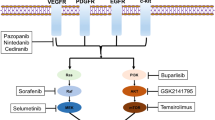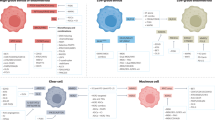Abstract
Despite frequent responses to chemotherapy, curative treatment remains elusive for the majority of patients with metastatic solid tumors. By contrast, in testicular cancer, gestational choriocarcinoma, Hodgkin disease and high-grade lymphomas, chemotherapy is routinely curative, even for patients who present with widely disseminated disease. In the common advanced cancers, however, over 40 years of cytotoxic drug development has brought no significant change in cure rates. One interpretation is that the intrinsic properties of the malignancies themselves, rather than the qualities of individual drugs or combination therapies, are primarily responsible for their curability with chemotherapy. We suggest that the curability of these malignancies results from an intrinsic 'locked-in' state of sensitivity to proapoptotic stresses in these cells. A common property of such curable malignancies is that they arise from cells that undergo major genetic rearrangements or recombination as part of their normal physiology. The absence of further genetic and epigenetic changes in genes that regulate apoptosis, DNA repair and senescence allows these cells to maintain their intrinsic sensitivity to chemotherapy. This process allows the cells, when challenged with chemotherapy, to undergo the natural apoptotic pathways that contribute to their intrinsic qualities of chemosensitivity and high curability.
Key Points
-
Curability with cytotoxic chemotherapy is restricted to a very few types of cancer
-
Cancers currently curable by chemotherapy include testicular and ovarian germ-cell tumors, high-grade non-Hodgkin lymphoma (B cell and T cell), Hodgkin disease and gestational choriocarcinoma
-
Clinical and experimental evidence implies that curability results from the biological properties of specific cancers rather than properties of the drugs used to treat them
-
Chemotherapy-curable cancers all arise in cell types whose normal physiological function involves complex rearrangement and/or recombination of genomic DNA
-
Chemotherapy-curable cancers have an intrinsic hypersensitivity to DNA damage, associated with a low threshold to undergo apoptosis, which reflects the function(s) of the cell types they are derived from
This is a preview of subscription content, access via your institution
Access options
Subscribe to this journal
Receive 12 print issues and online access
$209.00 per year
only $17.42 per issue
Buy this article
- Purchase on Springer Link
- Instant access to full article PDF
Prices may be subject to local taxes which are calculated during checkout
Similar content being viewed by others
References
Romond EH et al. (2005) Trastuzumab plus adjuvant chemotherapy for operable HER2-positive breast cancer. N Engl J Med 353: 1673–1684
Coiffier B et al. (2002) CHOP chemotherapy plus rituximab compared with CHOP alone in elderly patients with diffuse large-B-cell lymphoma. N Engl J Med 346: 235–242
Druker BJ et al. (2001) Efficacy and safety of a specific inhibitor of the BCR–ABL tyrosine kinase in chronic myeloid leukemia. N Engl J Med 344: 1031–1037
Heinrich MC et al. (2002) Inhibition of KIT tyrosine kinase activity: a novel molecular approach to the treatment of KIT-positive malignancies. J Clin Oncol 20: 1692–1703
Li MC et al. (1958) Therapy of choriocarcinoma and related trophoblastic tumors with folic acid and purine antagonists. N Engl J Med 259: 66–74
Hertz R et al. (1958) Chemotherapy of choriocarcinoma and related trophoblastic tumors in women. J Am Med Assoc 168: 845–854
McNeish IA et al. (2002) Low-risk persistent gestational trophoblastic disease: outcome after initial treatment with low-dose methotrexate and folinic acid from 1992 to 2000. J Clin Oncol 20: 1838–1844
Bower M et al. (1996) Placental site trophoblastic tumor: molecular analysis and clinical experience. Clin Cancer Res 2: 897–902
Williams SD et al. (1987) Treatment of disseminated germ-cell tumors with cisplatin, bleomycin, and either vinblastine or etoposide. N Engl J Med 316: 1435–1440
Murugaesu N et al. (2006) Malignant ovarian germ cell tumors: identification of novel prognostic markers and long-term outcome after multimodality treatment. J Clin Oncol 24: 4862–4866
Hasenclever D and Diehl V (1998) A prognostic score for advanced Hodgkin's disease. International Prognostic Factors Project on Advanced Hodgkin's Disease. N Engl J Med 339: 1506–1514
Sehn LH et al. (2007) The revised International Prognostic Index (R-IPI) is a better predictor of outcome than the standard IPI for patients with diffuse large B-cell lymphoma treated with R-CHOP. Blood 109: 1857–1861
Souhami RL et al. (1997) Five-day oral etoposide treatment for advanced small-cell lung cancer: randomized comparison with intravenous chemotherapy. J Natl Cancer Inst 89: 577–580
Mouridsen HT et al. (1977) Evaluation of single-drug versus multiple-drug chemotherapy in the treatment of advanced breast cancer. Cancer Treat Rep 61: 47–50
Stebbing J and Crook T (2007) Cytotoxic-free treatment designs: time to resistance. Nat Clin Pract Oncol 4: 1
International Collaborative Ovarian Neoplasm Group (2002) Paclitaxel plus carboplatin versus standard chemotherapy with either single-agent carboplatin or cyclophosphamide, doxorubicin, and cisplatin in women with ovarian cancer: the ICON3 randomised trial. Lancet 360: 505–515
Serrone L et al. (2000) Dacarbazine-based chemotherapy for metastatic melanoma: thirty-year experience overview. J Exp Clin Cancer Res 19: 21–34
Abou-Alfa GK et al. (2006) Randomized phase III study of exatecan and gemcitabine compared with gemcitabine alone in untreated advanced pancreatic cancer. J Clin Oncol 24: 4441–4447
Carbone PP et al. (1968) Management of patients with malignant lymphoma: a comparative study with cyclophosphamide and vinca alkaloids. Cancer Res 28: 811–822
Horwich A et al. (2000) A medical research council randomized trial of single agent carboplatin versus etoposide and cisplatin for advanced metastatic seminoma. MRC Testicular Tumour Working Party. Br J Cancer 83: 1623–1629
Mackenzie AR (1966) Chemotherapy of metastatic testis cancer. Results in 154 patients. Cancer 19: 1369–1376
Mackenzie AR (1966) The chemotherapy of metastatic seminoma. J Urol 96: 790–793
Longo DL et al. (1986) Twenty years of MOPP therapy for Hodgkin's disease. J Clin Oncol 4: 1295–1306
De Vita VT et al. (1972) Proceedings: Malignant lymphoma: treatment with combination chemotherapy. Proc Natl Cancer Conf 7: 379–390
Bagley CM et al. (1972) Advanced lymphosarcoma: intensive cyclical combination chemotherapy with cyclophosphamide, vincristine, and prednisone. Ann Intern Med 76: 227–234
Sen S and D'Incalci M (1992) Apoptosis. Biochemical events and relevance to cancer chemotherapy. FEBS Lett 307: 122–127
Johnstone RW et al. (2002) Apoptosis: a link between cancer genetics and chemotherapy. Cell 108: 153–164
Barnhart KT et al. (2003) The medical management of ectopic pregnancy: a meta-analysis comparing 'single dose' and 'multidose' regimens. Obstet Gynecol 101: 778–784
Creinin MD et al. (1996) Methotrexate and misoprostol for early abortion: a multicenter trial. I. Safety and efficacy. Contraception 53: 321–327
Doll DC et al. (1989) Antineoplastic agents and pregnancy. Semin Oncol 16: 337–346
Cardonick E and Iacobucci A (2004) Use of chemotherapy during human pregnancy. Lancet Oncol 5: 283–291
Matsui Y (1998) Regulation of germ cell death in mammalian gonads. Apmis 106: 142–147
Schwartz D et al. (1999) P53 controls low DNA damage-dependent premeiotic checkpoint and facilitates DNA repair during spermatogenesis. Cell Growth Differ 10: 665–675
Houldsworth J et al. (1997) Aberrant expression of cyclin D2 is an early event in human male germ cell tumorigenesis. Cell Growth Differ 8: 293–299
Sicinski P et al. (1996) Cyclin D2 is an FSH-responsive gene involved in gonadal cell proliferation and oncogenesis. Nature 384: 470–474
Trimmer EE et al. (1998) Human testis-determining factor SRY binds to the major DNA adduct of cisplatin and a putative target sequence with comparable affinities. Biochemistry 37: 352–362
Koberle B et al. (1997) DNA repair capacity and cisplatin sensitivity of human testis tumour cells. Int J Cancer 70: 551–555
Chresta CM et al. (1996) Hypersensitivity of human testicular tumors to etoposide-induced apoptosis is associated with functional p53 and a high Bax:Bcl-2 ratio. Cancer Res 56: 1834–1841
Balzer BL and Ulbright TM (2006) Spontaneous regression of testicular germ cell tumors: an analysis of 42 cases. Am J Surg Pathol 30: 858–865
Baltaci S et al. (2001) P53, Bcl-2 and Bax immunoreactivity as predictors of response and outcome after chemotherapy for metastatic germ cell testicular tumours. BJU Int 87: 661–666
Mayer F et al. (2003) Molecular determinants of treatment response in human germ cell tumors. Clin Cancer Res 9: 767–773
Houldsworth J et al. (1998) Human male germ cell tumor resistance to cisplatin is linked to TP53 gene mutation. Oncogene 16: 2345–2349
Wang X et al. (1996) Genetic basis of drug sensitivity in human testis tumour cells. Int J Cancer 65: 426–431
Rathmell JC and Thompson CB (2002) Pathways of apoptosis in lymphocyte development, homeostasis, and disease. Cell 109 (Suppl): S97–S107
Bassing CH et al. (2002) The mechanism and regulation of chromosomal V(D)J recombination. Cell 109 (Suppl): S45–S55
Borghesi L et al. (2004) B lineage-specific regulation of V(D)J recombinase activity is established in common lymphoid progenitors. J Exp Med 199: 491–502
Odegard VH and Schatz DG (2006) Targeting of somatic hypermutation. Nat Rev Immunol 6: 573–583
Lam QL et al. (2007) Impaired V(D)J recombination and increased apoptosis among B cell precursors in the bone marrow of c-Abl-deficient mice. Int Immunol 19: 267–276
Longerich S et al. (2005) The very 5´ end and the constant region of Ig genes are spared from somatic mutation because AID does not access these regions. J Exp Med 202: 1443–1454
Storb U and Stavnezer J (2002) Immunoglobulin genes: generating diversity with AID and UNG. Curr Biol 12: R725–R727
Rathmell JC (2004) B-cell homeostasis: digital survival or analog growth. Immunol Rev 197: 116–128
Li A et al. (2004) Utilization of Ig heavy chain variable, diversity, and joining gene segments in children with B-lineage acute lymphoblastic leukemia: implications for the mechanisms of VDJ recombination and for pathogenesis. Blood 103: 4602–4609
Pui CH et al. (2001) Childhood acute lymphoblastic leukaemia—current status and future perspectives. Lancet Oncol 2: 597–607
Holleman A et al. (2006) The expression of 70 apoptosis genes in relation to lineage, genetic subtype, cellular drug resistance, and outcome in childhood acute lymphoblastic leukemia. Blood 107: 769–776
Alizadeh AA et al. (2000) Distinct types of diffuse large B-cell lymphoma identified by gene expression profiling. Nature 403: 503–511
Shipp MA et al. (2002) Diffuse large B-cell lymphoma outcome prediction by gene-expression profiling and supervised machine learning. Nat Med 8: 68–74
Brenner C and Kroemer G (2000) Apoptosis. Mitochondria—the death signal integrators. Science 289: 1150–1151
Hans CP et al. (2005) Expression of PKC-beta or cyclin D2 predicts for inferior survival in diffuse large B-cell lymphoma. Mod Pathol 18: 1377–1384
Decouvelaere AV et al. (2007) Heterogeneity of protein kinase C beta(2) expression in lymphoid malignancies. Histopathology 50: 561–566
Klein U et al. (2001) Gene expression profiling of B cell chronic lymphocytic leukemia reveals a homogeneous phenotype related to memory B cells. J Exp Med 194: 1625–1638
Kienle D et al. (2003) VH mutation status and VDJ rearrangement structure in mantle cell lymphoma: correlation with genomic aberrations, clinical characteristics, and outcome. Blood 102: 3003–3009
Lossos IS et al. (2002) Apoptosis stimulating protein of p53 (ASPP2) expression differs in diffuse large B-cell and follicular center lymphoma: correlation with clinical outcome. Leuk Lymphoma 43: 2309–2317
Kuppers R and Rajewsky K (1998) The origin of Hodgkin and Reed/Sternberg cells in Hodgkin's disease. Annu Rev Immunol 16: 471–493
Oancea M et al. (2004) Apoptosis of multiple myeloma. Int J Hematol 80: 224–231
Terpos E et al. (2005) Current treatment options for myeloma. Expert Opin Pharmacother 6: 1127–1142
Kim YH et al. (1999) Clinical characteristics and long-term outcome of patients with generalized patch and/or plaque (T2) mycosis fungoides. Arch Dermatol 135: 26–32
Geissinger E et al. (2004) Nodal peripheral T-cell lymphomas and, in particular, their lymphoepithelioid (Lennert's) variant are often derived from CD8+ cytotoxic T-cells. Virchows Arch 445: 334–343
Gascoyne RD et al. (1999) Prognostic significance of anaplastic lymphoma kinase (ALK) protein expression in adults with anaplastic large cell lymphoma. Blood 93: 3913–3921
Bonzheim I et al. (2004) Anaplastic large cell lymphomas lack the expression of T-cell receptor molecules or molecules of proximal T-cell receptor signaling. Blood 104: 3358–3360
Ngan S and Seckl MJ (2007) Gestational trophoblastic neoplasia management: an update. Curr Opin Oncol 19: 486–491
Halperin R et al. (2000) Expression of the p53 gene and apoptosis in gestational trophoblastic disease. Placenta 21: 58–62
Wong SY et al. (1999) Apoptosis in gestational trophoblastic disease is correlated with clinical outcome and Bcl-2 expression but not Bax expression. Mod Pathol 12: 1025–1033
Mayhew TM (2001) Villous trophoblast of human placenta: a coherent view of its turnover, repair and contributions to villous development and maturation. Histol Histopathol 16: 1213–1224
Straszewski-Chavez SL et al. (2005) The role of apoptosis in the regulation of trophoblast survival and differentiation during pregnancy. Endocr Rev 26: 877–897
Straszewski-Chavez SL et al. (2007) XAF1 mediates tumor necrosis factor-alpha-induced apoptosis and X-linked inhibitor of apoptosis cleavage by acting through the mitochondrial pathway. J Biol Chem 282: 13059–13072
Ratts VS et al. (2000) Expression of BCL-2, BAX and BAK in the trophoblast layer of the term human placenta: a unique model of apoptosis within a syncytium. Placenta 21: 361–366
Horowitz J (1999) Adenovirus-mediated p53 gene therapy: overview of preclinical studies and potential clinical applications. Curr Opin Mol Ther 1: 500–509
Takenobu T et al. (2002) Development of p53 protein transduction therapy using membrane-permeable peptides and the application to oral cancer cells. Mol Cancer Ther 1: 1043–1049
Roth JA (2006) Adenovirus p53 gene therapy. Expert Opin Biol Ther 6: 55–61
Zeimet AG and Marth C (2003) Why did p53 gene therapy fail in ovarian cancer. Lancet Oncol 4: 415–422
Kantarjian HM (2007) Recent experience with decitabine in MDS. Clin Adv Hematol Oncol 5:140
Pfreundschuh M et al. (2006) CHOP-like chemotherapy plus rituximab versus CHOP-like chemotherapy alone in young patients with good-prognosis diffuse large-B-cell lymphoma: a randomised controlled trial by the MabThera International Trial (MINT) Group. Lancet Oncol 7: 379–391
Forstpointner R et al. (2004) The addition of rituximab to a combination of fludarabine, cyclophosphamide, mitoxantrone (FCM) significantly increases the response rate and prolongs survival as compared with FCM alone in patients with relapsed and refractory follicular and mantle cell lymphomas: results of a prospective randomized study of the German Low-Grade Lymphoma Study Group. Blood 104: 3064–3071
Acknowledgements
Work in the laboratory of T Crook is funded by Breakthrough Breast Cancer, The Institute of Cancer Research and Cancer Research UK. T Crook is a clinical scientist of Cancer Research UK.
Author information
Authors and Affiliations
Corresponding author
Ethics declarations
Competing interests
The authors declare no competing financial interests.
Rights and permissions
About this article
Cite this article
Savage, P., Stebbing, J., Bower, M. et al. Why does cytotoxic chemotherapy cure only some cancers?. Nat Rev Clin Oncol 6, 43–52 (2009). https://doi.org/10.1038/ncponc1260
Received:
Accepted:
Published:
Issue Date:
DOI: https://doi.org/10.1038/ncponc1260
This article is cited by
-
Angiogenesis and chemotherapy resistance: optimizing chemotherapy scheduling using mathematical modeling
Journal of Cancer Research and Clinical Oncology (2021)
-
Chemotherapy curable malignancies and cancer stem cells: a biological review and hypothesis
BMC Cancer (2016)
-
Cancer biomarker discovery is improved by accounting for variability in general levels of drug sensitivity in pre-clinical models
Genome Biology (2016)
-
Clinical observations on chemotherapy curable malignancies: unique genetic events, frozen development and enduring apoptotic potential
BMC Cancer (2015)
-
Targeting tumour-supportive cellular machineries in anticancer drug development
Nature Reviews Drug Discovery (2014)



